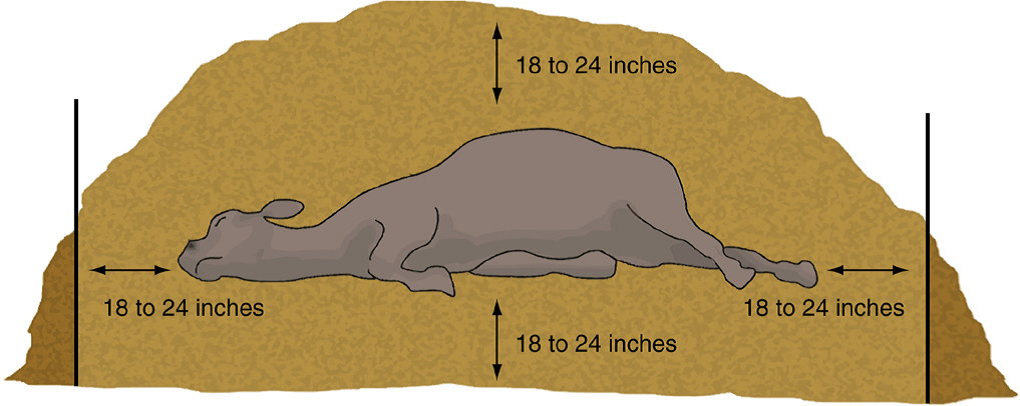
Livestock Mortality Management
Dr. Josh Payne, Oklahoma State University Extension Area Animal Waste Management Specialist
Livestock mortality is an issue encountered by every rancher. Mortality may be associated with disease, injury, age, or a catastrophic event. Following mortality, the carcass must be properly disposed of according to local regulations. For many ranchers, carcass disposal options are limited and can be costly. Improper disposal of animal carcasses, such as abandonment, can present potential environmental, animal and public health risks, and is illegal in most states.
Common methods for livestock mortality disposal include burial, incineration, rendering, landfills and composting. Burial requires that local environmental guidelines be followed, requires heavy equipment, may temporarily disturb the land needed for grazing and brings the carcass closer to the water table. Proper incineration requires a closed air unit, can be costly due to fuel costs and is mainly designed for smaller animals; dismemberment may be required for larger carcasses. Although rendering is a very effective method for carcass disposal, rendering is limited by the small and declining number of rendering facilities. Disposing of carcasses at a licensed landfill that accepts animal mortalities is another form of burial. Landfills may require notification before delivery and tipping fees often range from $20-$40/ton. Both rendering and landfill disposal require transportation of the carcass off-site which may increase biosecurity risks during a disease outbreak.
Composting bovine mortalities is a relatively inexpensive, biosecure, and environmentally sound approach to addressing the issue of carcass disposal when properly managed. By definition, composting is a controlled biological decomposition process that converts organic matter into a stable, humus-like product. Composting animal carcasses is characterized by microbial breakdown of a large centralized nitrogen source, the carcass, which is surrounded by a carbon source, the bulking agent. The process begins with an initial breakdown of carcass soft tissue by naturally present microorganisms which produce heat and carbon dioxide as by-products. Following soft tissue decomposition, thorough mixing of the bulking agent and carcass promotes an ideal blend of carbon and nitrogen for optimum composting. The bulking agent traps leachate and odors produced during the process, therefore acting as a biofilter between the carcass and the environment. The continuous high temperatures (>130°F) achieved through proper composting will destroy most pathogens and viruses. Microorganisms will eventually degrade the carcass leaving only a few remaining bones. This valuable by-product can then be land applied as a fertilizer source, recycling nutrients and organic matter to the soil, or reused to compost additional mortalities. Research conducted at OSU has demonstrated that stocker calves can be composted within 5 months using wood shavings or a mixture of shavings and manure. For more information on managing livestock mortalities, refer to OSU Fact Sheet: On-Farm Mortality Composting of Livestock Carcasses.
Editors Note: Although this article and fact sheet were written in Oklahoma, Florida law, and the Florida Cow/calf BMP Manual do have specific requirements and guidelines for livestock carcass disposal:
Florida Statute 823.041 Disposal of bodies of dead animals; penalty.
 0
0
